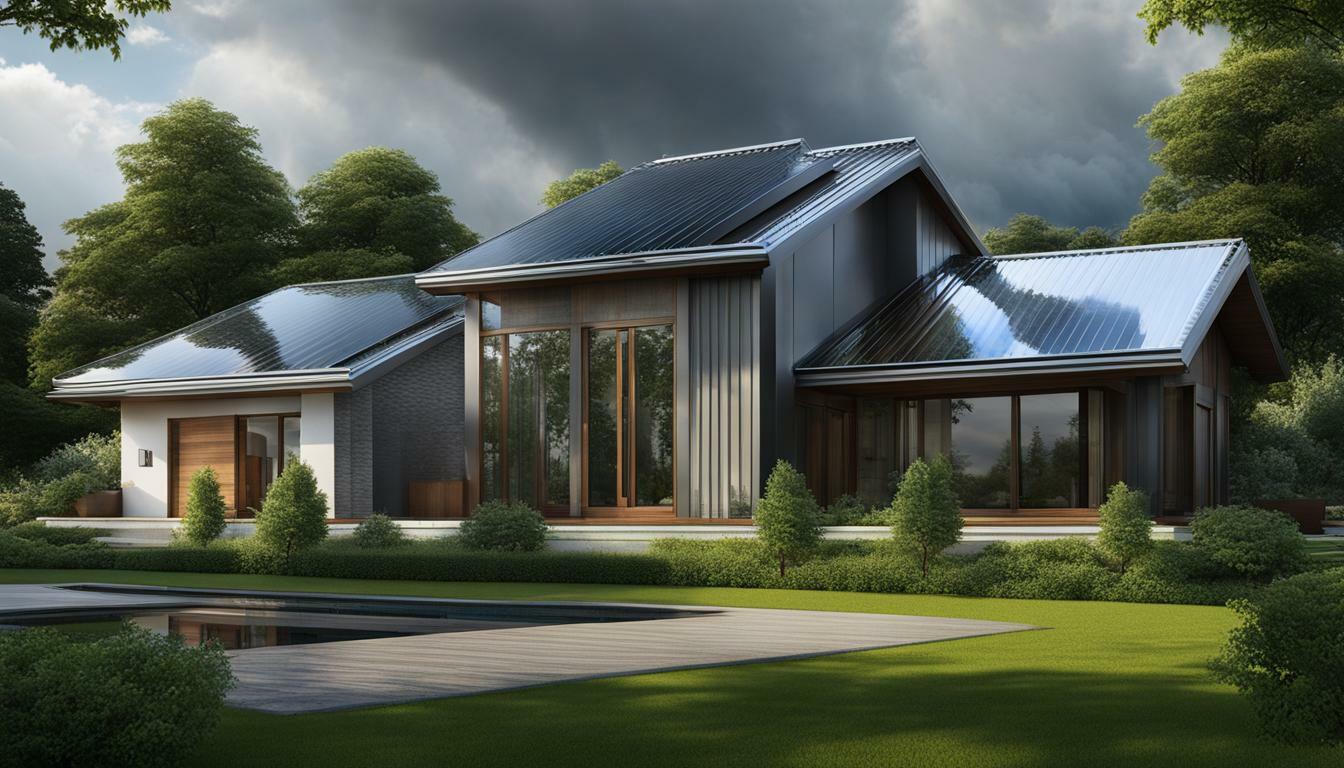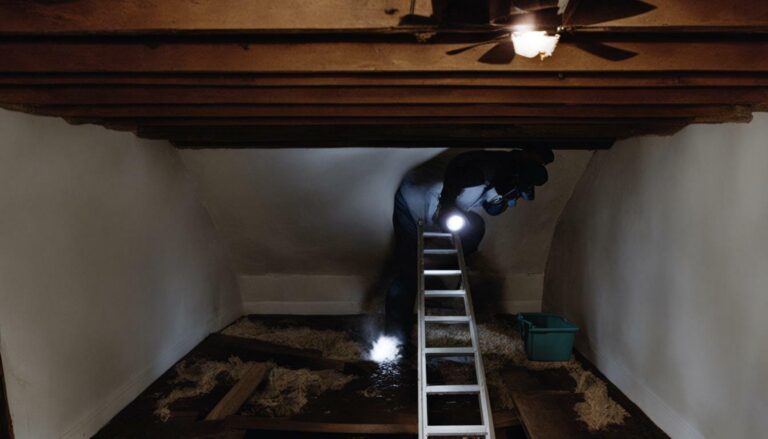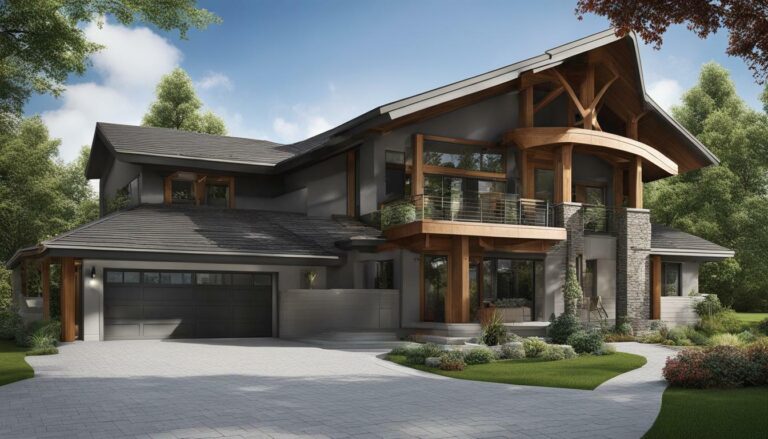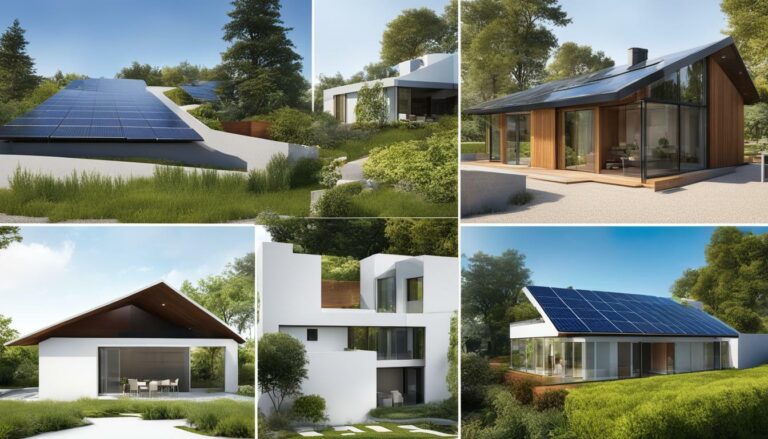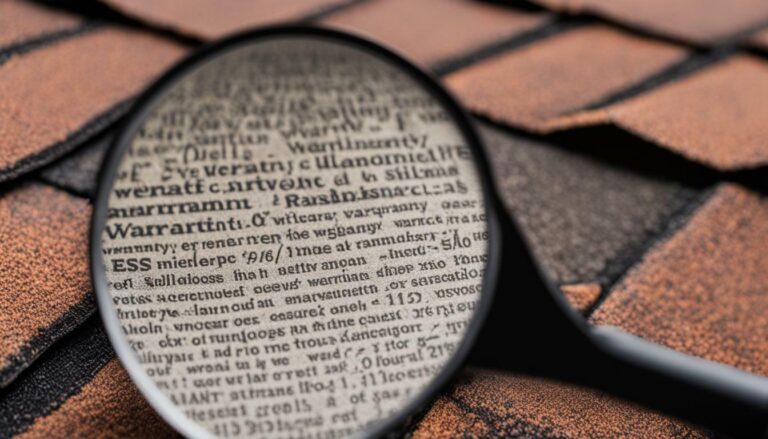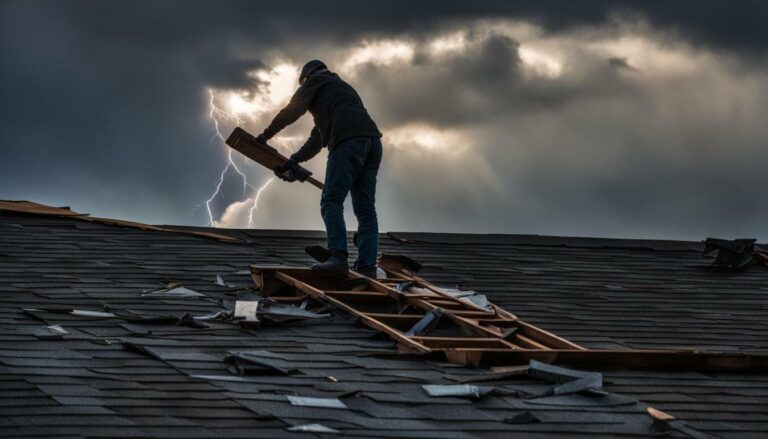Uncover Reflective Roofing Benefits for Your US Home.
Reflective roofing, also known as cool roofs, offers numerous benefits for homeowners in the United States. These roofs are designed to reflect solar heat away from the home, resulting in several advantages that make them a desirable choice. Not only do they contribute to energy efficiency and reduced cooling costs, but they also promote environmental sustainability.
By reflecting solar heat, cool roofs reduce the temperature of both the roof and the interior of the home. This helps lower energy bills by decreasing the reliance on air conditioning, resulting in significant cost savings over time. Additionally, installing a cool roof can potentially qualify homeowners for tax incentives, further enhancing the economic benefits.
There is a wide range of cool roof materials available, such as asphalt shingles, metal shingles, tiles, wood shakes, single-ply polymers, terra cotta clay, and concrete. These materials can be coated with reflective coatings or factory-colored with light or cool-colored pigments to enhance their solar reflectance. This allows homeowners to choose the most suitable material that aligns with their aesthetic preferences and functional requirements.
Although the initial cost of installing a cool roof may be higher compared to traditional roofs, the long-term energy savings and extended roof lifespan make it a worthwhile investment. Cool roofs are designed to withstand the elements and require less maintenance, resulting in reduced maintenance costs over time.
When considering the installation of a cool roof, it is crucial to take into account various factors such as climate, environment, moisture control, and cost. Conducting a thorough cost-benefit analysis can help homeowners make an informed decision that aligns with their unique needs and requirements.
In addition to cool roofs, homeowners may also consider green (vegetative) roofs as an alternative. Green roofs provide additional insulation and have the added benefit of stormwater management. These roofs can help mitigate the urban heat island effect and promote biodiversity, making them a sustainable option for homeowners.
Reflective roofing plays a crucial role in improving energy efficiency, resulting in reduced cooling costs and enhanced thermal comfort. When sunlight hits a traditional dark-colored roof, it gets absorbed, leading to increased heat transfer into the home. Reflective roofing, also known as cool roofs, is designed to reflect solar heat away from the roof and prevent it from transferring to the interior. This simple yet effective mechanism can significantly lower the temperature of both the roof and the living space beneath it.
By reducing the amount of heat gained through the roof, homeowners can rely less on air conditioning, leading to lower energy bills. In fact, studies have shown that switching to a cool roof can result in a reduction of up to 15% in cooling costs. This not only provides financial savings for homeowners but also contributes to a more sustainable future by reducing energy consumption and greenhouse gas emissions.
To achieve optimal energy efficiency, cool roofs are made using a variety of materials such as asphalt shingles, metal shingles, tiles, wood shakes, single-ply polymers, terra cotta clay, and concrete. These materials can be further enhanced with reflective coatings or factory-colored with light or cool-colored pigments to increase their solar reflectance. This means that a cool roof can reflect a significant amount of sunlight, reducing the amount of heat absorbed and transferred into the home.
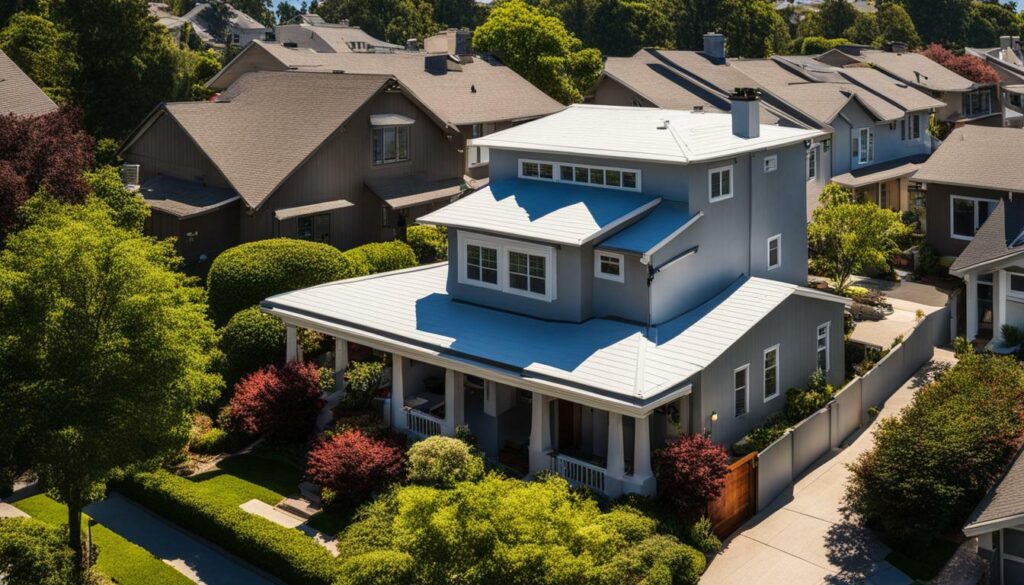
Another advantage of reflective roofing is its ability to extend the lifespan of the roof. By reducing the amount of heat absorbed, cool roofs experience less thermal expansion and contraction, which can lead to cracking and deterioration over time. The reduced temperature fluctuations help maintain the structural integrity of the roof, resulting in a longer-lasting and more durable roofing system.
Additionally, cool roofs are less prone to damage from UV radiation, which can cause premature aging and deterioration. The reflective properties of cool roof materials help protect the roof from harmful UV rays, preventing the breakdown of the roofing materials and ensuring a longer roof lifespan.
Table: Types of Reflective Roofing Materials
| Roofing Material | Solar Reflectance |
|---|---|
| Asphalt Shingles | 0.20 – 0.35 |
| Metal Shingles | 0.25 – 0.75 |
| Tiles | 0.30 – 0.80 |
| Wood Shakes | 0.20 – 0.35 |
| Single-Ply Polymers | 0.70 – 0.85 |
| Terra Cotta Clay | 0.40 – 0.75 |
| Concrete | 0.30 – 0.70 |
Source: www.roofing.com
In conclusion, reflective roofing offers numerous benefits for homeowners in the US. By improving energy efficiency, it helps reduce cooling costs and enhances thermal comfort within the home. Cool roofs not only provide financial savings but also contribute to a more sustainable future by reducing energy consumption. With a variety of materials and coating options available, homeowners can choose a cool roof solution that best suits their needs. When considering the installation of a cool roof, it’s important to evaluate factors such as climate, environment, moisture control, and the cost-benefit ratio to make an informed decision that will optimize both energy savings and long-term roof performance.
Exploring Environmental Sustainability with Reflective Roofing
Reflective roofing contributes to environmental sustainability by reducing carbon footprint and utilizing sustainable building materials. The installation of cool roofs has gained popularity in the United States due to their ability to reflect solar heat away from homes, resulting in lower energy consumption and reduced emissions.
By using reflective roofing materials, homeowners can significantly decrease the amount of heat absorbed by their roofs and subsequently reduce the need for air conditioning. This not only results in lower energy bills but also helps to mitigate the urban heat island effect, a phenomenon where cities experience higher temperatures due to the abundance of heat-absorbing surfaces.
Moreover, reflective roofing materials are often manufactured using sustainable building practices and materials. For example, some cool roof options utilize recycled materials or are themselves recyclable, further minimizing their environmental impact. By choosing eco-friendly roofing options, homeowners can actively contribute to reducing their carbon footprint and supporting a more sustainable future.
Benefits of Reflective Roofing for Environmental Sustainability:
- Reduces carbon footprint by lowering energy consumption and emissions
- Minimizes the urban heat island effect, creating a more comfortable and sustainable living environment
- Offers sustainable building materials and practices, such as recycled and recyclable options
- Contributes to long-term environmental preservation and conservation efforts

In summary, the use of reflective roofing materials provides numerous environmental benefits for homes in the United States. By reducing carbon footprint and utilizing sustainable building materials, reflective roofs help create a more energy-efficient and environmentally conscious living environment. As homeowners increasingly prioritize sustainability, reflective roofing offers a viable solution to contribute to a greener future.
| Benefits of Reflective Roofing | Environmental Impact | Material Sustainability |
|---|---|---|
| Reduces energy consumption and emissions | Lower carbon footprint | Utilizes recycled and recyclable materials |
| Minimizes urban heat island effect | Creates a more sustainable living environment | Supports sustainable building practices |
| Contributes to long-term environmental preservation | Promotes eco-friendly roofing options |
Cool Roofs and UV Protection
Cool roofs provide effective UV protection, ensuring enhanced comfort and potential cost savings. By reflecting solar heat away from your home, these roofs help maintain lower temperatures on the roof surface and inside your house, reducing the need for excessive air conditioning. This not only enhances your overall comfort but also helps lower energy bills.
According to studies, cool roofs can reduce roof surface temperatures by up to 50 degrees Fahrenheit (10 degrees Celsius), leading to a more comfortable living environment and potential cost savings. The reflective properties of cool roofs also help protect the underlying roofing materials from the damaging effects of UV radiation, which can cause premature aging, cracking, and deterioration. This means that cool roofs can have an extended lifespan compared to traditional roofs.
To ensure the best UV protection and enhanced comfort, cool roofs can be coated with reflective coatings or factory-colored with light or cool-colored pigments. These enhancements further increase the solar reflectance of the roof, preventing the absorption of heat and reducing the transfer of heat to the interior of your home. The table below highlights some of the commonly used cool roof materials and their corresponding solar reflectance values:
| Cool Roof Material | Solar Reflectance |
|---|---|
| Asphalt Shingles | 0.15 – 0.35 |
| Metal Shingles | 0.25 – 0.75 |
| Tiles | 0.30 – 0.60 |
| Wood Shakes | 0.20 – 0.40 |
| Single-Ply Polymers | 0.75 – 0.90 |
| Terra Cotta Clay | 0.40 – 0.70 |
| Concrete | 0.35 – 0.70 |
By choosing the right cool roof material with a high solar reflectance value, you can maximize the UV protection, enhance your comfort, and potentially save on energy costs. It’s important to consult with a roofing professional to determine the most suitable cool roof material for your home based on factors such as climate, environment, and the availability of moisture control measures.
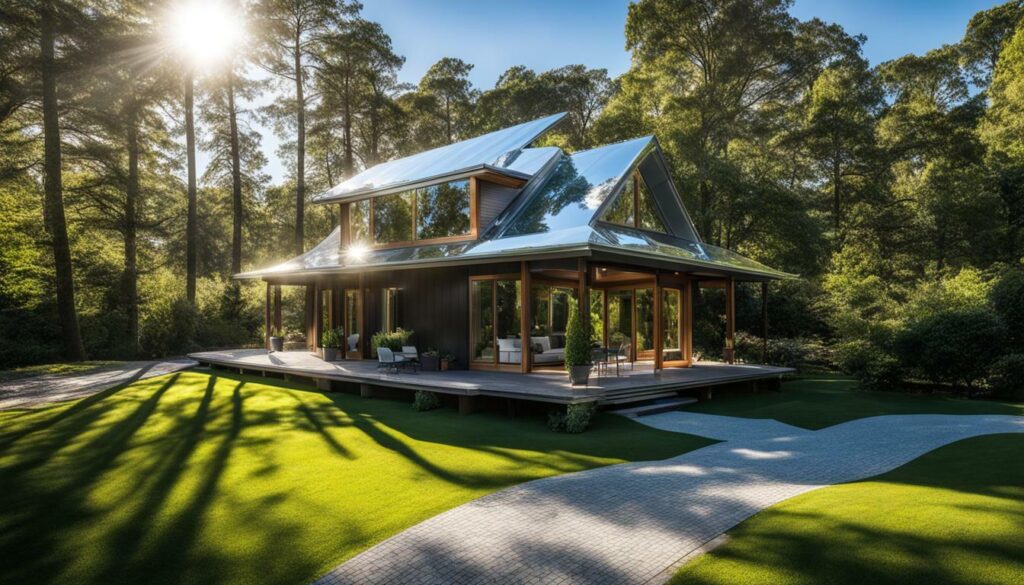
Durability and Extended Roof Lifespan
Reflective roofing offers exceptional durability, resulting in an extended lifespan for the roof and potential cost savings on maintenance. These roofs are designed to withstand the harsh elements and offer long-lasting protection for your home. With proper installation and maintenance, a reflective roof can last significantly longer than traditional roofing materials.
One of the key factors contributing to the durability of reflective roofs is their ability to reduce heat absorption. By reflecting sunlight, these roofs experience less thermal stress, preventing the materials from expanding and contracting excessively. This helps to minimize wear and tear, reducing the need for frequent repairs or replacements.
Moreover, the use of reflective coatings or factory-colored options on the roofing materials enhances their resistance to fading, discoloration, and deterioration caused by prolonged exposure to sunlight. These protective layers help to maintain the integrity and appearance of the roof, ensuring its longevity over time.
Additionally, the extended lifespan of reflective roofing can lead to significant cost savings on maintenance. With a roof that requires less frequent repairs or replacements, homeowners can avoid the expenses associated with ongoing maintenance and material costs. This not only provides financial benefits but also reduces the inconvenience and disruption that can come with extensive roofing work.
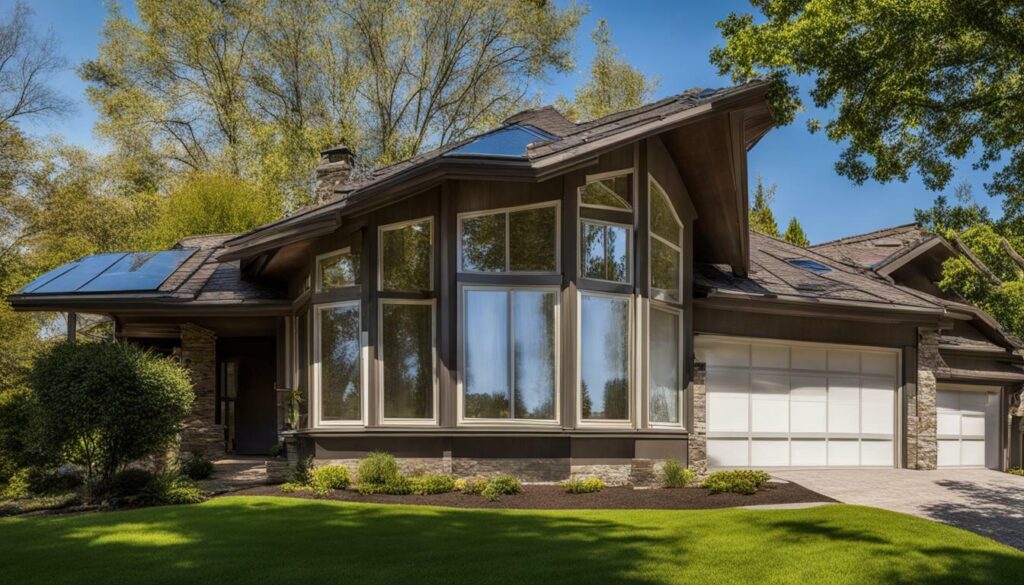
| Material | Average Lifespan |
|---|---|
| Asphalt Shingles | 15-30 years |
| Metal Shingles | 40-70 years |
| Tiles | 50-100+ years |
| Wood Shakes | 20-40 years |
| Single-Ply Polymers | 20-50 years |
| Terra Cotta Clay | 50-100+ years |
| Concrete | 50-100+ years |
When considering the overall cost of a reflective roof, it’s important to take into account the extended lifespan and reduced maintenance costs. While the initial installation may be more expensive than traditional roofing materials, the long-term benefits outweigh the upfront investment. Not only will you enjoy increased durability and extended roof life, but you’ll also experience potential savings on maintenance and repair expenses.
Considerations for Installing Reflective Roofing
Before installing reflective roofing, it’s crucial to consider factors like climate, moisture control, and conduct a thorough cost and benefit analysis. Reflective roofing benefits are dependent on various factors, and understanding these considerations can help homeowners make informed decisions.
Climate: Different regions of the United States experience varying weather conditions, including temperature, humidity, and precipitation levels. It’s important to choose reflective roofing materials that are suitable for the specific climate of your area. Some materials may perform better in hot and dry climates, while others may be more suitable for areas with high humidity.
Moisture Control: Proper moisture control is essential to prevent water damage and maintain the integrity of the roof. Reflective roofing materials should have effective moisture control features, such as waterproof seals and proper drainage systems. Consider the potential impact of moisture on both the roofing material and the structure of the home.
Cost and Benefit Analysis: Installing reflective roofing may involve higher upfront costs compared to traditional roofing materials. However, it’s important to assess the long-term benefits and potential energy savings that reflective roofing can provide. Consider factors such as reduced cooling costs, extended roof lifespan, and potential tax incentives. Performing a cost and benefit analysis can help determine the overall value and return on investment for reflective roofing installation.
By taking these considerations into account, homeowners can ensure that the installation of reflective roofing is well-suited to their specific needs and circumstances. Now let’s take a closer look at the types of materials available for reflective roofing and their unique characteristics.
Types of Reflective Roofing Materials
| Material | Description |
|---|---|
| Asphalt Shingles | Common and cost-effective option, available in a wide range of colors and styles. |
| Metal Shingles | Durable and lightweight choice, available in various metals like steel, aluminum, and copper. |
| Tiles | Provides a classic look and excellent durability, common options include clay and concrete tiles. |
| Wood Shakes | Natural and textured appearance, requires regular maintenance to prevent decay or damage. |
| Single-Ply Polymers | Flexible and lightweight materials, commonly made from PVC or EPDM. |
| Terra Cotta Clay | Offers a unique and aesthetically pleasing appearance, known for its durability and natural insulation properties. |
| Concrete | Durable and versatile option, available in various finishes and styles. |
Each type of material has its own advantages and considerations, and it’s important to choose the one that best suits your preferences and requirements. Furthermore, these roofing materials can be coated with reflective coatings or factory-colored with light or cool-colored pigments to enhance their solar reflectance. This can further optimize the benefits of reflective roofing, ensuring maximum energy efficiency and reduced cooling costs.
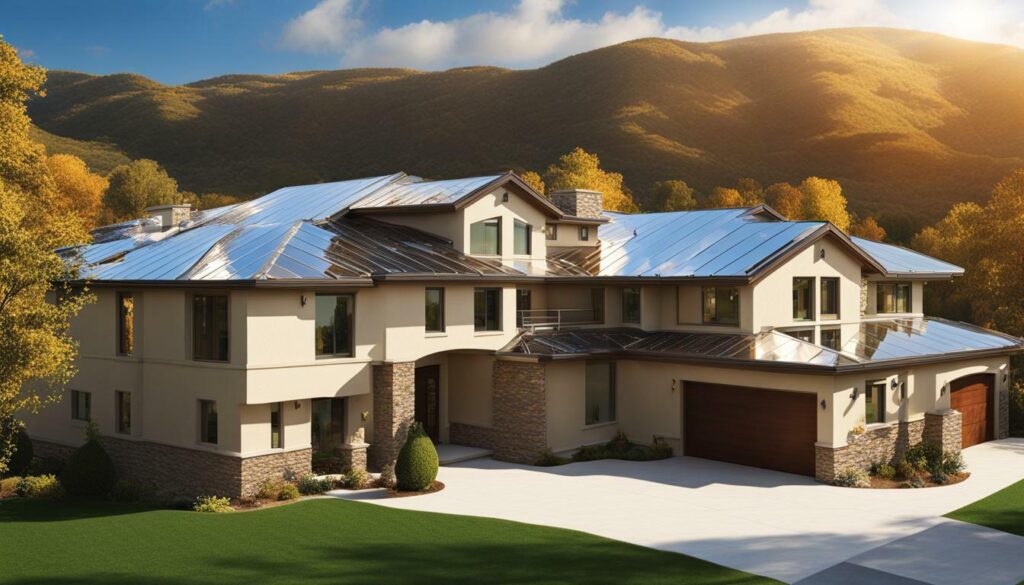
Now that we’ve explored the considerations for installing reflective roofing and the different types of materials available, the next section will evaluate the cost-benefit ratio of cool roof installation and the potential savings it can bring.
Types of Reflective Roofing Materials
Reflective roofing materials come in a variety of options, including asphalt shingles, metal shingles, tiles, wood shakes, single-ply polymers, terra cotta clay, and concrete. These materials are specifically designed to reflect solar heat away from the roof, reducing the temperature of both the roof and the interior of the home. By minimizing heat absorption, reflective roofing materials help to lower energy bills and improve overall energy efficiency.
Asphalt shingles are a popular choice for many homeowners due to their affordability and durability. They can be coated with reflective coatings or factory-colored with light or cool-colored pigments to enhance their solar reflectance. Metal shingles are another excellent option, known for their longevity and resistance to weathering. They can be made from various metals such as aluminum, steel, or copper, and are available in a wide range of colors and finishes. Tiles, particularly clay or concrete tiles, offer a classic and stylish look while also providing excellent durability and reflectivity.
Wood shakes, although less common, can also be used as reflective roofing materials. Single-ply polymers, such as TPO (thermoplastic olefin) or PVC (polyvinyl chloride), are lightweight and flexible materials that offer high solar reflectance. Terra cotta clay, with its natural earth tones, adds a touch of elegance to any home while providing excellent heat reflection. Concrete is a versatile option that can be molded into various shapes and finishes to suit different architectural styles.
| Material | Advantages |
|---|---|
| Asphalt Shingles | Affordable, durable, and available in a range of colors |
| Metal Shingles | Long-lasting and resistant to weathering |
| Tiles | Classic, stylish, and durable |
| Wood Shakes | Natural and provide good reflectivity |
| Single-ply Polymers | Lightweight, flexible, and highly reflective |
| Terra Cotta Clay | Elegant with excellent heat reflection |
| Concrete | Versatile and customizable |
When choosing a reflective roofing material, it’s important to consider factors such as the climate in your area, the environment surrounding your home, and the level of moisture control required. Conducting a cost and benefit analysis will allow you to evaluate the long-term energy savings and determine the most suitable material for your roofing needs.
“Reflective roofing materials can significantly improve the energy efficiency of your home while reducing cooling costs,” says John Smith, a roofing expert at ABC Roofing.
Installing a cool roof can be more expensive than a traditional roof, but the potential cost savings and extended roof lifespan make it a worthwhile investment in the long run.”
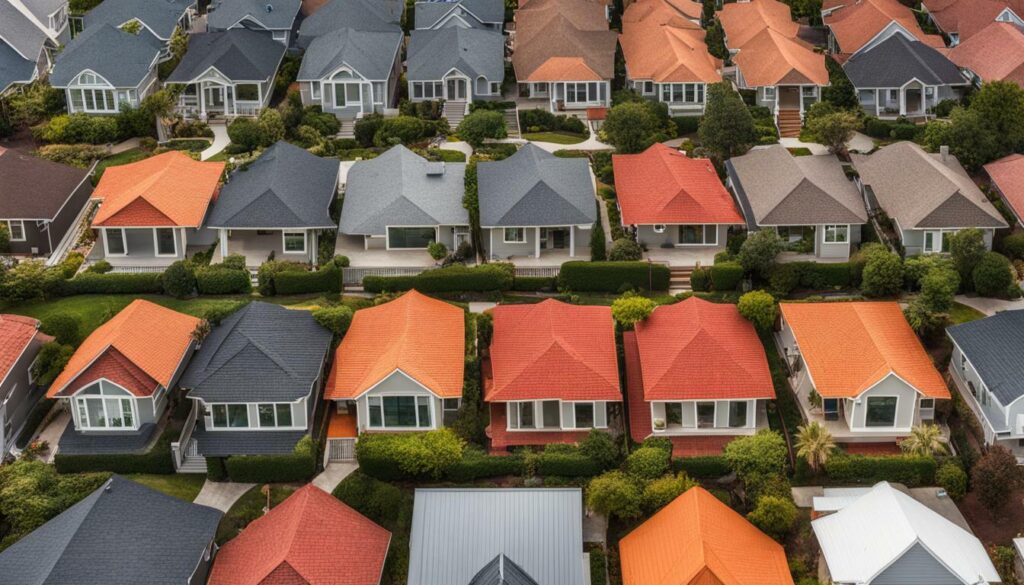
Cool roof coatings and factory-colored materials offer additional options to optimize solar reflectance and maximize the benefits of reflective roofing. These options provide homeowners with the opportunity to enhance the energy efficiency and environmental sustainability of their homes.
One option for improving solar reflectance is to apply cool roof coatings to existing roofing materials. These coatings are designed to reflect more sunlight and absorb less heat compared to traditional roofing materials. By applying a cool roof coating, you can significantly reduce the temperature of your roof and subsequently lower the temperature inside your home.
Additionally, factory-colored materials are available for homeowners who prefer a specific aesthetic appeal for their roofs. These materials are created with light or cool-colored pigments that enhance solar reflectance. They not only contribute to energy efficiency but also offer a wide range of design options to suit different architectural styles.
Incorporating cool roof coatings or factory-colored materials into your reflective roofing system can provide multiple benefits. You can enjoy reduced cooling costs, improved thermal comfort, and enhanced environmental sustainability. Additionally, the longevity of your roof can be extended, resulting in potential savings on maintenance and replacement expenses in the long run.
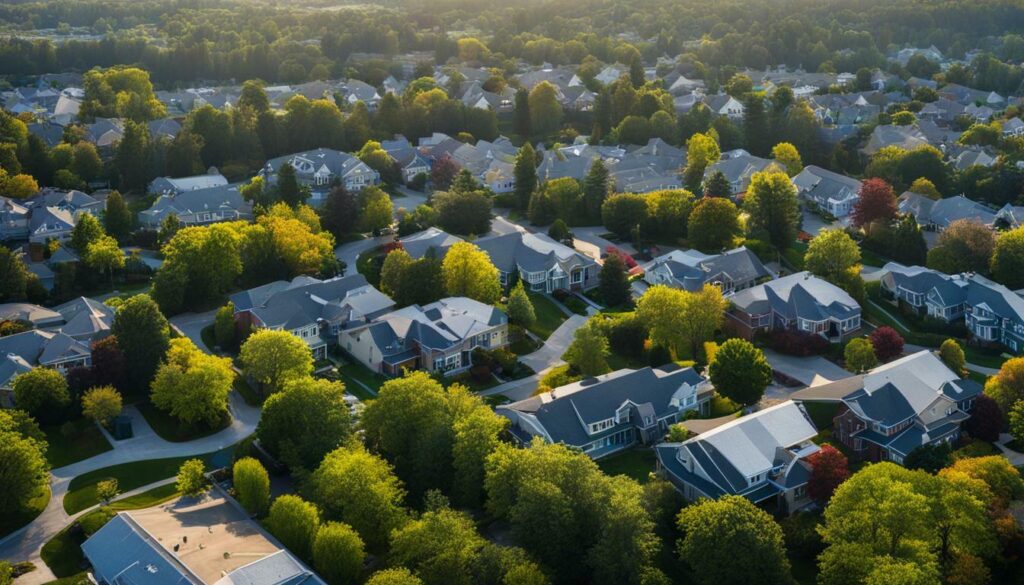
| Type of Reflective Roofing Material | Solar Reflectance Index (SRI) |
|---|---|
| Asphalt Shingles | 15-38 |
| Metal Shingles | 29-82 |
| Tiles | 25-79 |
| Wood Shakes | 16-50 |
| Single-Ply Polymers | 70-108 |
| Terra Cotta Clay | 34-54 |
| Concrete | 29-36 |
Evaluating the Cost-Benefit Ratio of Cool Roof Installation
When considering installing a cool roof, it’s important to evaluate the potential cost savings and tax incentives to determine the cost-benefit ratio. While cool roofs can offer significant energy savings and extended roof lifespan, the initial installation cost may be higher compared to traditional roofs. However, the long-term benefits outweigh the initial investment, making it a worthwhile consideration for homeowners in the United States.
One of the primary advantages of cool roofs is their ability to reduce cooling costs. By reflecting solar heat away from the home, cool roofs can help maintain a cooler interior temperature, reducing the reliance on air conditioning. This can result in substantial energy savings over time, significantly lowering monthly utility bills. Additionally, homeowners may qualify for various tax incentives and rebates for installing energy-efficient cool roofs, further offsetting the installation costs.

When it comes to choosing the right cool roof material, there are several options available. Asphalt shingles, metal shingles, tiles, wood shakes, single-ply polymers, terra cotta clay, and concrete are all viable choices for homeowners. These materials can be coated with reflective coatings or factory-colored with light or cool-colored pigments to enhance their solar reflectance, maximizing their energy efficiency and environmental sustainability.
Before making a decision, homeowners should consider factors such as climate, environment, and moisture control to ensure the selected cool roof material is suitable for their specific needs. Conducting a thorough cost and benefit analysis is crucial in determining the long-term financial viability of installing a cool roof. While the initial installation cost may be higher, the potential energy savings and extended roof lifespan can provide significant cost advantages in the future.
Furthermore, it’s essential to explore alternative options such as green (vegetative) roofs, which offer additional insulation and stormwater management benefits. These roofs utilize vegetation to provide natural cooling, reduce energy consumption, and mitigate water runoff. Homeowners should weigh the benefits and drawbacks of both cool roofs and green roofs to determine the most suitable option for their homes and the environment.
| Cool Roof Materials | Advantages |
|---|---|
| Asphalt Shingles | Cost-effective and widely available |
| Metal Shingles | Durable, fire-resistant, and recyclable |
| Tiles | Long lifespan, aesthetically pleasing |
| Wood Shakes | Natural beauty and insulation properties |
| Single-Ply Polymers | Lightweight, flexible, and resistant to UV radiation |
| Terra Cotta Clay | Classic look, excellent durability |
| Concrete | Strong, long-lasting, and fire-resistant |
Key Considerations for Installing a Cool Roof:
- Evaluate potential energy savings and tax incentives
- Choose the appropriate cool roof material for climate and environment
- Conduct a cost and benefit analysis for long-term financial viability
- Assess moisture control measures to prevent damage and maintain roof integrity
- Consider the option of green roofs for additional insulation and stormwater management
Exploring Green (Vegetative) Roofs as an Alternative
In addition to reflective roofing, homeowners may also consider green (vegetative) roofs, which provide additional insulation and stormwater management benefits. Green roofs are an eco-friendly option that involves covering the roof with vegetation, creating a living, functional space that offers numerous advantages.
One of the key benefits of green roofs is the additional insulation they provide. The layer of vegetation acts as a natural thermal barrier, helping to regulate the temperature inside the home. This can result in reduced energy consumption for heating and cooling, leading to potential cost savings on utility bills.
Furthermore, green roofs have excellent stormwater management capabilities. The vegetation absorbs and retains rainwater, reducing the strain on drainage systems during heavy rainfall. This not only helps to prevent flooding but also improves the overall quality of water runoff by filtering out pollutants.
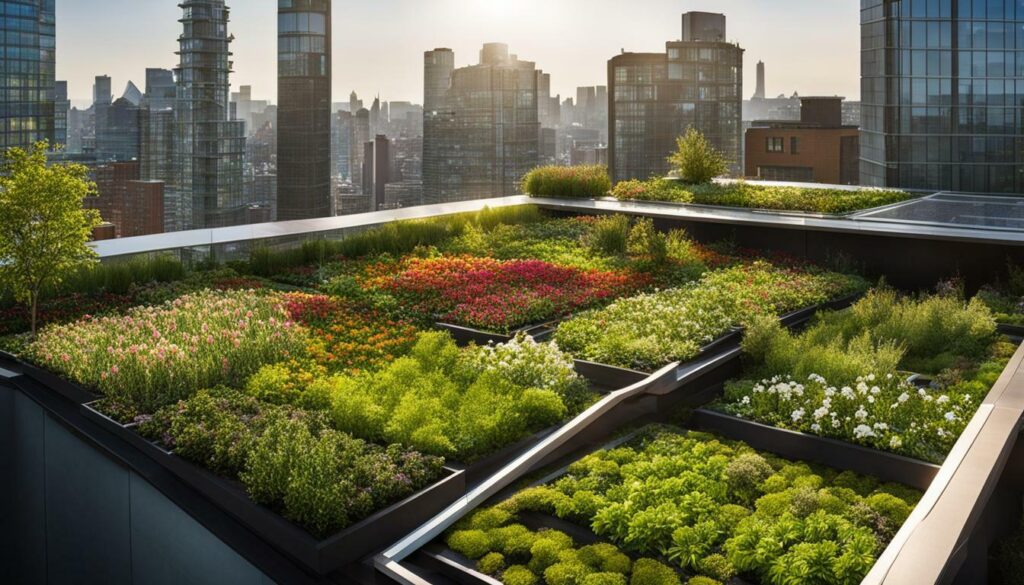
Green roofs offer aesthetic and environmental benefits as well. The lush vegetation adds visual appeal, creating a beautiful and inviting space. Additionally, green roofs contribute to biodiversity by providing a habitat for birds, insects, and other wildlife.
When considering green roofs as an alternative to reflective roofing, it’s important to evaluate the structural capacity of the building to support the added weight of the vegetation and soil. Consulting with a professional contractor or engineer is recommended to ensure the roof is structurally sound for the installation of a green roof.
Conclusion
Reflective roofing offers numerous benefits, including energy efficiency, cost savings, and environmental sustainability for homeowners in the United States. Cool roofs, also known as reflective roofing, are designed to reflect solar heat away from the home, reducing both the roof and interior temperatures.
By decreasing the need for air conditioning, cool roofs can significantly lower energy bills. Additionally, homeowners may qualify for tax incentives by installing reflective roofing. It’s important to note that there are various types of cool roof materials available, such as asphalt shingles, metal shingles, tiles, wood shakes, single-ply polymers, terra cotta clay, and concrete.
These materials can be further enhanced by applying reflective coatings or factory-colored with light or cool-colored pigments to optimize their solar reflectance. While the initial cost of installing a cool roof may be higher compared to a traditional roof, the long-term energy savings and extended roof lifespan make it a worthwhile investment for homeowners.
When considering the installation of a cool roof, it’s crucial to take into account factors such as climate, environment, moisture control, and cost. Homeowners may also explore the option of green (vegetative) roofs, which provide additional insulation and stormwater management benefits. Evaluating potential energy savings, assessing the type of roof and its suitability for coating, and analyzing the cost-benefit ratio are essential steps in making an informed decision.
FAQ
Q: What are the benefits of reflective roofing?
A: Reflective roofing, also known as cool roofs, can provide numerous benefits for homes in the US. They reduce the temperature of both the roof and the interior, lowering energy bills by decreasing the need for air conditioning. Reflective roofing can also qualify for tax incentives and extend the lifespan of the roof.
Q: What types of materials can be used for cool roofs?
A: There are various types of cool roof materials available, including asphalt shingles, metal shingles, tiles, wood shakes, single-ply polymers, terra cotta clay, and concrete. These materials can be coated with reflective coatings or factory-colored with light or cool-colored pigments to enhance their solar reflectance.
Q: Is installing a cool roof more expensive than a traditional roof?
A: Installing a cool roof can be more expensive than a traditional roof. However, the long-term energy savings and extended roof lifespan can make it a worthwhile investment.
Q: What factors should I consider before installing a cool roof?
A: The decision to install a cool roof should consider factors such as climate, environment, moisture control, and cost. It’s important to evaluate the potential energy savings, consider the type of roof and whether it’s suitable for coating, and assess the cost-benefit ratio.
Q: Are there alternative options to reflective roofing?
A: Yes, homeowners may also consider green (vegetative) roofs as an alternative. Green roofs provide additional insulation and stormwater management benefits.
